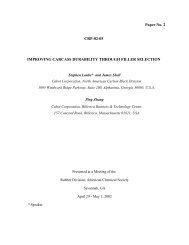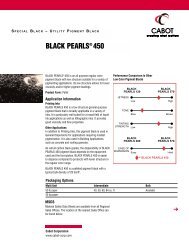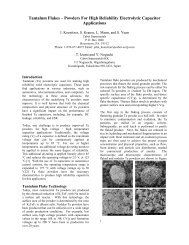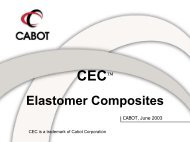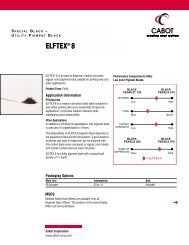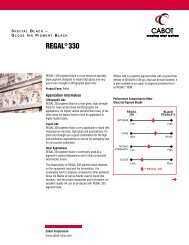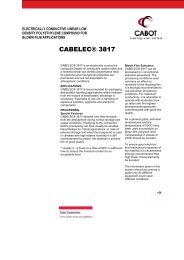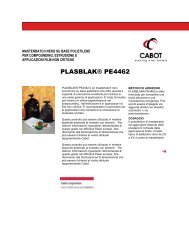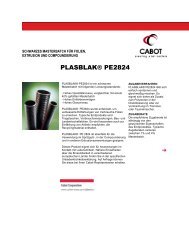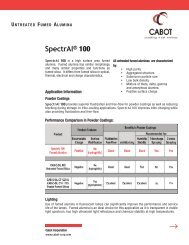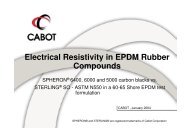Effect of Functionalization of Carbon Black on Rubber Properties
Effect of Functionalization of Carbon Black on Rubber Properties
Effect of Functionalization of Carbon Black on Rubber Properties
Create successful ePaper yourself
Turn your PDF publications into a flip-book with our unique Google optimized e-Paper software.
12.0<br />
10.0<br />
8.0<br />
6.0<br />
4.0<br />
2.0<br />
0.0<br />
Strain, %<br />
0.0<br />
Strain, %<br />
0.1 1 10 100 0.1 1 10 100<br />
Figure 8. Strain dependence <str<strong>on</strong>g>of</str<strong>on</strong>g> G' at 70°C and 10 Hz for OESSBR/BR and NR compounds filled with a variety <str<strong>on</strong>g>of</str<strong>on</strong>g> fillers<br />
strain dependence <str<strong>on</strong>g>of</str<strong>on</strong>g> the elastic modulus, G’(Figure 8). For filled rubber, the elastic<br />
modulus decreases with strain amplitude, which has been termed the “Payne effect”. 7<br />
This effect is generally used as a measure <str<strong>on</strong>g>of</str<strong>on</strong>g> filler networking, c<strong>on</strong>trolled mainly by<br />
filler-filler interacti<strong>on</strong>. 8 Although from the chemical compositi<strong>on</strong> point <str<strong>on</strong>g>of</str<strong>on</strong>g> view, both<br />
CSDPF 2000 and 4000 are between carb<strong>on</strong> black and silica, what is actually observed<br />
here is that the two new fillers give the lowest Payne effect. This unique behavior <str<strong>on</strong>g>of</str<strong>on</strong>g> the<br />
two new materials is readily explained by the low filler-filler interacti<strong>on</strong> due to their<br />
hybrid surfaces. It has been established that from the point <str<strong>on</strong>g>of</str<strong>on</strong>g> view <str<strong>on</strong>g>of</str<strong>on</strong>g> surface energies,<br />
interacti<strong>on</strong> between unlike surfaces is lower than that between the same category<br />
surfaces. 1<br />
G', MPa<br />
Silica<br />
N234<br />
CRX4210<br />
CRX4210/TESPT 2.7 phr<br />
OESSBR/BR 70/30,<br />
Filler: equal volume<br />
70°C, 10 Hz<br />
Due to the higher surface activity <strong>on</strong> the surface <str<strong>on</strong>g>of</str<strong>on</strong>g> carb<strong>on</strong> domains and lower filler-filler<br />
interacti<strong>on</strong>, it is evident that these fillers will require significantly lower silane coupling<br />
agent compared to silica.<br />
Applicati<strong>on</strong> <str<strong>on</strong>g>of</str<strong>on</strong>g> CSDPF 2000 and CSDPF 4000 in Tire Tread Compounds<br />
Following the discussi<strong>on</strong> <strong>on</strong> the filler parameters that c<strong>on</strong>trol the tire performance, the<br />
higher polymer-filler interacti<strong>on</strong> and lower filler-filler interacti<strong>on</strong> <str<strong>on</strong>g>of</str<strong>on</strong>g> CSDPF 2000 and<br />
4000 will allow a better compromise between abrasi<strong>on</strong> resistance and dynamic hysteresis<br />
at high temperature. This will result in a good wear resistance and rolling resistance<br />
compromise for the tires. With regard to wet skid resistance, the increased fricti<strong>on</strong><br />
10<br />
12.0<br />
10.0<br />
8.0<br />
6.0<br />
4.0<br />
2.0<br />
G', MPa<br />
Silica<br />
N134<br />
CRX2124<br />
CRX2124/TESPT 1.0 phr<br />
NR, Filler: 50 phr<br />
70°C, 10 Hz



